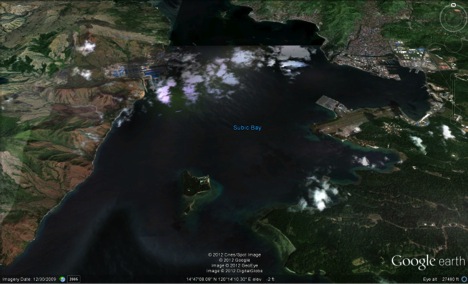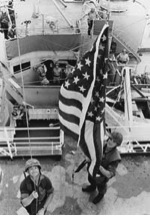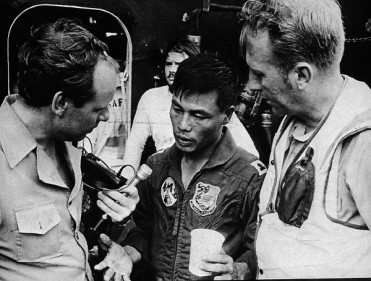Shipmates and Gentle Readers, this is a guest post from the Master Chief to complete the action after the end of the American War in Southeast Asia:
The last helos were on board and Midway Magic headed south to return the Air Force Jolly Greens the base at Utapao and finally get some liberty for the crew, which was cut short when we left to take our station off of Vietnam.
You may be thinking that Air Wing FIVE, left behind in the Philippines, was having a great time drinking San Miguel beer and hanging out on Magsaysay Boulevard with the working girls. Not so. In the middle of Subic Bay the Navy maintained a recreational area on Grande Island. It was a great place for snorkeling and putt-putt golf, healthy activities away from the fleshpots of Olongapo City. The island soon became a refugee camp for the Vietnamese fleeing by boats. Air Wing Sailors left behind were put to work feeding and caring for what became a small Vietnamese town.

(The Subic Bay Naval Complex. Grande Island to center left, the runways of NAS Cubi Point to the right.)
Midway arrived off the coast of Thailand and was given a new assignment.
Anyone that possessed the keys to an airplane in Vietnam flew that last day to freedom. We were given the job of hauling RVN Air Force F-5 fighters and A-37 light attack planes that had landed in Thailand to someplace ‘to be determined.’
The planes were carried to Midway-Maru by CH-53 Sea Stallions using a cargo sling, and dropped on the flight deck with Air America and Vietnamese helos. At least one jet slipped from the sling and ended up in the drink.
Leaving Thailand, we headed toward the Philiipines, but learned there would be an issue with the importation of the warplanes there and instead, we were directed to steam further east for Guam. During this transit we crossed several time zones and rather than maintaining one local time, “Midway time,” we adjusted our clocks forward and back to meet the actual time of the zone we were sailing.
To ensure the Navy got a good day’s work out of the Ship’s company, the clocks would be advanced at noon extending the work day an hour and if we lost an hour it was changed at midnight cutting sleep time by an hour!
When we arrived in Guam we were told only Sailors with family on the island would be granted liberty. One weather-guesser convinced his boss his brother was a missionary on the island. Steve was really a hardy steamer and was in dire need of a beer.
As the cranes started moving the planes from the flight deck to barges for the ride ashore every young lady put on her bikini and jumped in the family boat to make circles around the big aircraft carriers that rarely called at Agana. All we could do was fight over the “big eye” binoculars on the signal bridge to see what we were missing. I think you know what we said.
It took just over a day to offload the now-surplus warplanes and we finally pointed the ship west and headed back to the Philippines with the associated clock changes and the thoughts of cool San Miguels lagers to come. It was a tradition on Midway to have steak and lobster for dinner the night before arriving in port. After a great dinner, all we could do was dream about liberty in the PI. But Midway Magic was ready to sprinkle some fairy dust (also known a BOHICA) and our plans changed.
On May 12, the U.S.-flagged merchant ship SS Mayaguez was steaming near Cambodia when it was boarded and seized by pirates. The ship was taken to Khao Tang Island, about fifty clicks off the coast of Preah Sihanouk Province in the Gulf of Thailand.
Two days later the Ford Administration directed a rescue mission be launched to rescue the crew. Midway was secured and readied for sea. Marines landed on the island to rescue the crew and encountered heavy fire. The rescue effort resulted in the loss of 15 Marines, Sailors and Airmen KIA with an additional 23 Airmen killed when their helo crashed.
Midway received orders to skip our in-port period and steam to a point between the Philippines and Thailand to act as refueling lily pad for aircraft flying to the USS Coral Sea, which had been ordered to the scene.

(US Flag is raised on SS Mayaguez by Marines. US Navy Photo.)
The Mayaguez Rescue was over and Midway finally headed to Subic Bay. As tradition we had a second steak and lobster dinner and made ready for liberty. As colors were shifted—the U.S. ensign is moved from the main mast to the stern and the Navy Jack is raised on the bow when in port—the brows settled on the pier and a couple of pickup trucks arrived at the aft brow used by the enlisted Sailors.
When we went down the brow we were met by our skipper, CAPT L. C. Chambers, who gave us our choice of a couple of beers or sodas. Mission Complete.
Over the last 33 years I have often wondered about the Vietnamese and others that were rescued that day. When I meet Vietnamese people today I often ask when they came to America and often the answer is: April 1975.
Some, of course, followed in the infamous escape of the boat people in the 70s and 80s. When I asked a Lt Commander I served with in Texas when he came to America he went to his office and showed me a framed copy of Life magazine and pointed out his family crowded on the deck of a junk.
In January I had some neck bones fused in a local hospital. The anesthesiologist came in before the surgery and I asked her when she or her family came to the States and she told me they were on one of the last flights out of Tan Son Nhut.
She did a great job on my surgery and I was glad she was in America.
The O-1 Birddog “Miracle Plane” now hangs on display at the U.S. National Naval Aviation Museum at NAS Pensacola. A similar model is on display aboard the San Diego USS Midway Museum, which hosted a reunion of Vietnamese refugees in 2005. The reunion included the pilot that landed the Birddog on the flight deck so long ago along with his entire family. There is a photograph of him in his traditional garb surrounded by the generations of children and grandchildren who are in America because the Midway was at the right place in the sea.

(Major Bung Ly is interviewed after he landed the “Bird Dog” aboard the USS Midway in April 1975. Ly flew his wife and five children to safety to escape Northern Vietnam troops encroaching on Saigon. Photo Courtesy Midway Museum.)
Copyright 2012
www.vicsocotra.com
